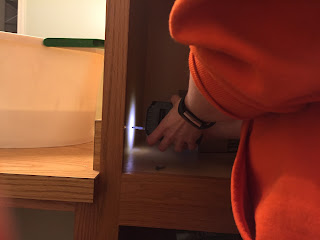

to this:
Huge difference! It looks so much neater and more sophisticated. Not to mention, I did it (with a little help from my husband)! And I learned a lot about learning from free tutorials on the internet, furniture refinishing, power tools, and frame building along the way.
This project helped me feel like a more competent homeowner. I am more capable than I thought I was when it comes to remodeling small projects. Overall, I really liked working with gel stain but YouTube was my friend when I had to troubleshoot. The first coat must be completely dry before applying a second. Otherwise, you will end up removing the first coat of stain. I also learned just how important it is to pay attention to weather conditions when waiting for gel stain to dry and to be patient. I have painted walls with latex paint and it is somewhat similar, but I felt this stain was a bit more particular to work with. If I were to try this project again, I might invest in a chemical deglosser like some of the tutorials. I am not sure if this would have an effect on how well the first coat adheres to the wood or not, but I think it might be worth trying. I would also buy some paint thinner to make clean up easier.
Learning how to use the basics on a drill, power sander and miter saw made this project so much easier than using hand tools. They really are worth learning how to use. They save time, can produce better results, and boost confidence! While I hated sanding, the sander was easier than using sandpaper and sanding block alone. I loved using the drill and saw and am glad I am no longer nervous to use our power tools. Knowing how to use them opens up so many more projects to me. (Thanks handy husband for showing me the ropes!)
Surprisingly I am also glad that framing the mirror gave me some difficulty, even more than figuring out the gel stain. Much like my students will have to do, it forced me to think outside the box and problem-solve. I did some research and tried something new. Better yet, it worked! While figuring out how to make my cuts with the saw more precise was frustrating, it was also empowering. I developed new skills and added a whole variety of items to the list of things I can now do! Like many, I dislike when I fail, but learning to find a way around the bumps in the road is important. It makes failure less scary and helps build a growth mindset. I built the frame and added hanging brackets on the back, then measured and used a level to find out where I needed to place my nails over the mirror.

The only thing I plan to do later is to dab some stain over the wood filler in the corners and to stain the inner edge of the frame. After hanging it over the mirror, I realized the mirror reflected the unfinished wood which looked strange. This was an awesome learning experience and I am so pleased with the end results of my project!






















